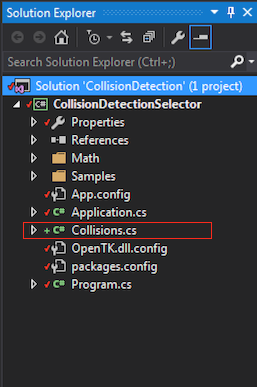Shapes & Points
We're going to start out by implementing some basic shapes (We're going to make classes for each shape) and methods to test if a point is inside any of the shapes. This may seem simple but it's the basis of collision detection. In later chapters we're going to add functionality to our existing shape classes.
You SHOULD NOT out put primitives in the Samples directory. Remember, only code that creates a window (or console) goes in sample. You might want to consider making a "Collision" directory or something.
Collision class
Aside from shapes and points, we're going to make a helper class called Collision. This class will hold the actual collision logic. It's going to contain only public static methods. This is an example of how collisions will work when we're done:
// THIS IS JUST SAMPLE CODE, DON'T COPY IT!
// Integrate function causes moving sphere to rest on plane
void Integrate(Sphere sphere, Plane plane, float velocity) {
// CollisionResult is a helper class, it contains information
// about a collision that could happen
CollisionResult collision = Collision.MovingSpherePlane(sphere, plane, velocity);
if (collision.happened) {
// Collision happened, offset the sphere to be above the plane
sphere.position = collision.point - collision.incident;
}
}
Let's Get Started!
- Add a new
Collision.csfile to the project - For now, this class is going to be empty

And let's just add the skeleton, like Program and Application this class is going to live in global scope.
using System;
using Math_Implementation;
class Collisions {
}